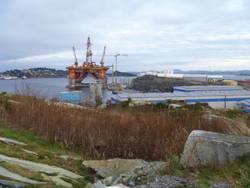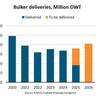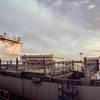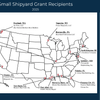The Hanseatic trading city of Bergen, on the edge of the Norwegian North Sea, has a long maritime tradition. From shipping to aquaculture to offshore oil and gas, this is a city whose economic identity is defined by its ties to the sea. The city is by far Norway´s largest port, with more than 13 million metric tonnes of cargo transported to and from Bergen in 2010. Bergen is also the country´s largest center for aquaculture and marine science research, and is home to the Institute of Marine Research and an active marine science research centre at the University of Bergen.
In addition, since the 1970s, Bergen has been a region of focus for Norway´s offshore oil and gas industry, given its strategic location close to several of Norway´s North Sea oil and gas fields. While Stavanger remains the Norwegian oil industry´s administrative hub, the Bergen region has established itself as a key operational base - today, the Bergen region is home to 60% of Statoil operations for the Norwegian Continental Shelf (NCS).
In particular, the Bergen region today is a leader in the field of subsea technology – companies here compete and collaborate to drive the development of new solutions for subsea oil and gas operations.
Though the term “cluster” is regularly bandied about around the world, the version created and touted in Bergen is true to the send of the work, part of a government investment in 12 regional groupings designated as Norwegian Centers of Expertise (NCE).
Known as NCE Subsea, the Bergen cluster´s activities support innovation, increased capacity and internationalization. Because the Bergen region has specific strengths in after-market activities, NCE Subsea is also highly specialized, focusing on maintenance, modification and operations (MMO).
The cluster is jointly administered by Innovation Norway, SIVA (the Industrial Development Corporation of Norway), and the Research Council of Norway.
In total, 124 companies and organizations are members of the NCE Subsea network, which is led by a board representing the entire Bergen region, as well as most of the key players in the Norwegian offshore and subsea sectors. Statoil, Aker Solutions, FMC, Coast Center Base and the research organization SINTEF Petroleum Research are all included on the board, which is led by Chair Mr. Tove Ormevik, OIM at Skarv FPSO for BP. The cluster benefits from the presence of the many large oil and gas companies in the Bergen area. companies like Aker Solutions, FMC, Statoil and DNV have a major presence here, alongside local companies with international reach such as Framo Engineering and DOF Subsea. Many of these companies are expanding their presence and facilities in and around Bergen.
The financial infusion that comes with being named an NCE has also helped the cluster to develop: the cluster organization receives $900,000 from the Norwegian government, for 12 years. NCE Subsea also benefits from project funding to supplement its operating budget.
Thanks to this support from the Norwegian government and additional contributions by members, the cluster organization itself is not profit-driven. But it is very clearly business-driven, and focussed on creating economic opportunities for members and partners.
Expanding Infrastructure
The official designation of the cluster in 2006 gave new profile to the Bergen region´s strengths and has encouraged companies to invest and develop in the region. Many companies are undertaking aggressive expansion programs, displaying their strong confidence in continued oil and gas-related activity on the Norwegian continental shelf.
Twenty minutes outside of Bergen, the benefits of geographical co-location within the cluster are on display. The Ågotnes industrial estate, just west of the city, is home to NCE Subsea´s offices, and also houses facilities of key players including Aker Solutions and Statoil.
Statoil´s main Bergen offices are at Sandsli, but its Subsea Pool, which manages Statoil´s tools for subsea production on the Norwegian continental shelf, maintains a facility at Ågotnes.
Aker Solutions´ expanded Ågotnes facility opened in 2009, and is the company´s largest subsea service and maintenance base worldwide. Ågotnes focusses on the refurbishment and upgrade of christmas trees used on subsea installations on the Norwegian Continental Shelf.
Coast Center Base (CCB), which is a 50% owner of the Ågotnes estate, also has a major facility here for logistics, maintenance and supply activities for North Sea oil and gas fields including Troll – the world´s largest subsea development – as well as Statfjord, Gullfaks, Veslefrikk, Huldra and Kvitebjørn.
Across the water from Ågotnes, Framo Engineering´s extensive new facility at Horsøy is visible. Framo is a Bergen-based product developer, supplier and system supplier, with three main product groups – pumps and subsea systems, multiphase metering, and swivels and marine systems.
Framo, which was fully acquired by Schlumberger in July 2011, purchased the former fish-processing site in 2007, and in 2008 began a $171m infrastructure development. The Horsøy site includes a harbor, a logistics worksite, R&D facilities, assembly, and testing, including the full-scale pressure testing of large systems. At a total of 750 000 sq. m., the site also has the potential for co-location of Framo´s sister and partner companies in the Bergen cluster.
Innovation, Collaboration
Companies in the cluster benefit from collaboration on subsea technology development, in many cases supported by Statoil. The Norwegian oil giant, which Fortune Magazine recently named one of the world´s 10 most innovative companies, is a major driver of innovation in the subsea sector, and is collaborating with several cluster members on new subsea technologies.
Statoil has an ambitious goal of achieving production of at least 20.5 million barrels per day by 2020. At least a third of this new production is projected to come from current wells, through both increased oil recovery and the extension of their productive lives.
Ove Magne Kallestad, Statoil´s Vice President of Subsea Technology & Operations, said that technology is essential to meeting this target. According to Kallestad, Statoil is focussed on both the reliable operation of existing wells and the development of new technology for the subsea.
Continued operation of existing wells requires upgrading and refurbishment of existing subsea technology. In Bergen, a major source of aftermarket activity is the ongoing need to refurbish of subsea christmas trees, which control the flow of subsea oil and gas.
While the average lifespan of a christmas tree is around 20 years, maintenance of either the tree or the well is typically required between 5 and 10 years after installation. Many of the trees in use today were installed in the 1990s, and now require maintenance and upgrading.
In Bergen, both FMC and Aker Solutions have facilities for christmas tree refurbishment at Ågotnes. Trees can be returned to their former operating capacity, and also upgraded to include new features and capabilities that have been developed in the past 20 years.
New technology is also critical, and since 2009 Statoil has been working with Framo Engineering on a subsea boosting system which uses Framo´s wet gas compressor technology to increase subsea gas production.
The compressor, which allows for boosting of gas containing both water and condensate, is as efficient as a conventional compressor and eliminates the need for upstream treatment of gas. Statoil is considering the technology as an option to maintain production on Gullfaks C beyond 2013, and to increase total recovery from the reservoir.
Framo has been working on this technology for ten years, and entered into a partnership and funding arrangement with Statoil in 2009. The compressor is presently undergoing testing at Framo´s Fusa facility, near Bergen. A decision is expected in early 2012 as to whether to adopt this technology concept for the Gullfaks C field.
Aker Solutions is also working with Statoil to bring to market with a new product aimed at improving recovery from mature fields.
Their power and communications system, known as PodEx, can be used to provide extra power and communications ability to existing subsea installations, without a wholesale upgrade.
This allows new tools and sensors to be installed on existing wells, without disruption. The first PodEx system is currently undergoing integration testing for Statoil's Njord field on the NCS, and Aker is expecting that it will be installed in 2012.
Meanwhile, smaller companies, such as independent Bergen company ClampOn, are also contributing to subsea technology innovation. ClampOn specializes in subsea ultrasonic sensor technology, building each sensor by hand in their Bergen facility. Their sensors help companies increase oil recovery by providing additional information to manage the flow of oil and gas.
Their products are non intrusive (they “clamp on” to an existing installation), and can be moved around without the risk of leakage.
ClampOn recently launched its Corrosion-Erosion Monitoring System (CEM), which allows for observation and management of corrosion and erosion in subsea pipes. This is particularly important when trying to safely extend the life of existing wells. The CEM has been in development for 10 years and uses acoustic transducers to send information about the condition of a section of pipe. ClampOn currently has two major orders for this product, one for a BP field life extension project in the Gulf of Mexico and one for Total in the North Sea.











